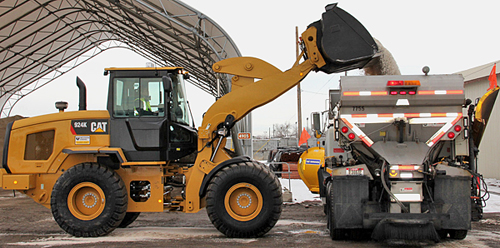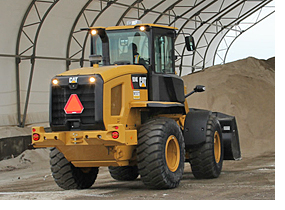

Salt brine and salt-sand mixtures important to winter highway maintenance
NOTE: This is the second of a two-part series on tools and techniques ITD uses to ensure driver safety during winter highway conditions.
Like a well-prepared handyman, ITD has several products in its arsenal to treat highways to remove snow and ice for the safety of drivers. Some of the products are limited to specific regions of the state. Some are used quite extensively. Some are more effective at higher temperatures and give way to other techniques as the highway surface temperatures drop. This week the Transporter looks at salt and sand mixtures and the use of salt brine (sodium chloride in solution).
Salt and sand mix
A mixture of salt and sand often is used at lower temperatures, combining the melting power of salt with the traction-enhancement and anti-skid properties of sand. On average, one truckload of straight salt will treat the same length of highway as six truckloads of the salt/sand mixture.
ITD has used salt mixed into the sanding material for decades. Covered sand sheds, widely used by ITD, plus a liberal mixture of salt in the sand piles, keeps stockpiles of sand pliable so loading equipment can dig into the piles to fill the trucks. Mixtures are usually at 3:1, 2:1 or 1:1 ratios of sand-to-salt, depending on the need.
“We use these tools on their own and in combination to provide the best surface for the motorist we can achieve,” said Doral Hoff, ITD’s north-central Idaho Maintenance Operations Manager. “We also use these in conjunction with weather forecasts to determine the timing of the applications.”
Salt brine (sodium chloride)
Another liquid application some ITD districts have adopted is a salt solution (brine) to increase efficiency and reduce costs. The savings mean snow-removal equipment and personnel can move on to lower-priority routes sooner, improving the level of service across the entire federal and state highway system.
Several ITD regions use straight road salt and salt brine, particularly in the more severe conditions of eastern and northern Idaho.
Salt and salt-brine also have an effective temperature: they work best when it is 25 degrees or higher and can be effective down to 5 degrees with proper timing and application rates. Unsalted anti-skid material (sand) is best used when crews are managing a snow floor in very cold environments until the temperature warms to allow effective chloride treatment.
Like magnesium chloride, salt brine can be used as a pre-treatment on the roadway before a storm to prevent ice from bonding with the highway surface. Salt brine and mag. chloride also can be applied directly during a snowstorm.
 Ken Hahn, the Maintenance Operations Manager in eastern Idaho, said his crews use salt and salt brine, monitor the weather forecasts for approaching storm fronts, pre-treat highways and attack the ice during and after the storm to achieve better results. The improved results are less snow on the road surface, reduced time the snow floor remains on the highway and less ice.
Ken Hahn, the Maintenance Operations Manager in eastern Idaho, said his crews use salt and salt brine, monitor the weather forecasts for approaching storm fronts, pre-treat highways and attack the ice during and after the storm to achieve better results. The improved results are less snow on the road surface, reduced time the snow floor remains on the highway and less ice.
Using deicers or salt-and-sand mixes is preferred, but occasionally, ITD will use straight sand. Efforts to reduce the use of sanding material have improved air quality in some cases. Reducing the amount of sand also minimizes other issues, including cleanup.
Gertonson said “solid salt is typically applied at 125 to 250 pounds per lane mile in southeast Idaho.” However, he said this winter, his region is experimenting with application rates of 100 pounds per lane mile, and had enough success that it has become standard practice.
“Spring sweeping cleanup of anti-skid material has been reduced from a month to several days,” Gertonson said. “In addition, those materials on the roadway at intersections can act as ball bearings, making it difficult for vehicles trying to stop.”
Minimizing the use of sanding material also prolongs the visibility of road markings. “Anti-skid material left over on the roadway during the winter and spring months nearly obliterated the paint markings on the roadway in the past,” Gertonson said. “Since our conversion to salt rather than anti-skid material, the pavement markings are visible the entire year.”
Gertonson said it also has an economic benefit because “moving to using mainly salt in lieu of anti-skid material during our winter storms has reduced to nearly zero the number of tort claims from the public for broken windshields.”
Between deicer, road salt, salt brine and sand, ITD typically goes through almost 200,000 tons (4 million pounds) of product each winter, and even more in severe conditions.
Mag chloride and salt brine remain ITD's liquid weapons of choice in the battle against snow and ice, although there are a "handful of other liquids being used across the state," said ITD Winter Maintenance Coordinator Dennis Jensen. "But they probably represent less than 5 percent of the total liquids used."
With multiple winter road-clearing tools they can employ, the department is able to meet its primary objective – improving the safety and mobility of drivers on Idaho highways.
“Technology is playing a huge role in helping us identify product success and developing cost-effective application rates,” Jensen said, referring to ITD’s nearly 100 Road and Weather Information System (RWIS) sites statewide. ITD expects to add another 35 stations this summer. Jensen said using the RWIS data to improve performance has gained interest globally, with presentation requests coming from across North America, Asia and Europe.
“We are able to see positive results through data collection and analysis that weren't available to us 10 years ago. Crews are now able to match the treatment to the individual storm events with very good success.”